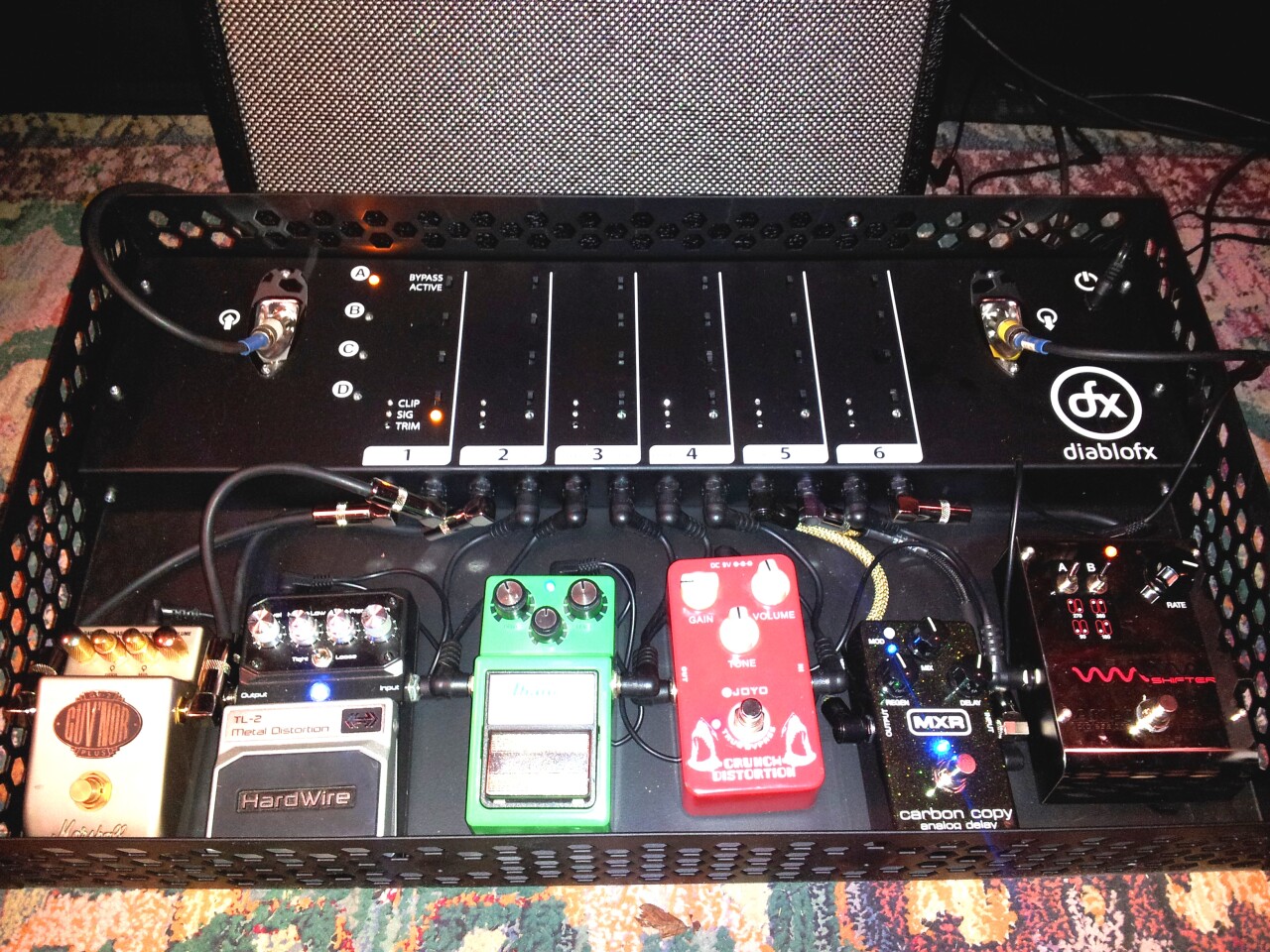While wireless technology has liberated many guitarists from the restrictions of a cord running to the amp, stomp box effects can still threaten to sully the stage with spaghetti madness. Ahead of the 2013 NAMM Show in Anaheim, California, Diablo FX has launched what's claimed to be the first high fidelity wireless all-in-one effects pedal management system. In addition to making the working area a safer and tidier place for players to strut their axe-wielding stuff, the Sound Control 6 system allows players to turn multiple analog or digital effects on/off in one stomp.
Working guitarists who haven't taken the sensible approach of building a pedal board can be faced with long effects setup and take-down and pack-away times, and lots of tangled or trailing cords and numerous power sources to contend with. Then there's the problem of light-fingered fans walking away with your prized Arbiter Fuzz Face (or even a full board) when your back is turned. Many effects can be hidden from view on rack-mounts, of course, and the use of a digital effects processor could help cut down on trailing cord clutter, but many players – including the co-founder of Diablo FX Joe Lockyer – prefer chained stomp boxes.
"I was playing with a digital combo box and found lots of great effects combinations, but digital guitar sound in a live performance always sounds thin, feedback is weird, decay is weird, high notes are piercing, and there's a bit of latency," the guitarist with rock group Five by Five told Gizmag. "So I went to analog pedals and tube amp, and at my first show I got lots of great feedback on how smooth my tone was."
"The problem was that set up and breakdown took too long and there were too many cords and pedals on stage," he added. "When pedals are off, the signal still passes through them. If you run it through ten, you have a corrupted signal. Additionally, tapdancing on pedals is difficult, if not impossible. For example, going from clean with chorus to lead with distortion, EQ and delay takes four pedal stomps in half a second. I can do it all now in one stomp."

Lockyer's answer was to work with Rick Schwab on the development of the Sound Control 6 system. Instead of giving effects pedals center stage placement (and allowing eager tone jockeys full exposure to your sonic setup secrets, or worse), the wireless effects management system allows the player to chain up to six stomp boxes in a solid steel cage and hide them from view, behind an amp perhaps, or even off-stage.
As you can see in the following demonstration video, the only equipment on show to the boisterous crowd of adoring fans out front is a 4-channel wireless stomp unit, which auto-links to the main cage that's home to the favored effects, so there's no need to worry about pairing or complicated setup.
Although the connection from instrument to the main unit is physical rather than wireless, Lockyer says that "you can run it directly into your personal wireless unit (like I do)."
"The footpedal transmits at 433 MHz using an auto-roll algorithm sending only channel switching info," he added. "It's impossible to steal the code or crossover to other devices."
When not in use, the wireless footpedal can be stored safely out of sight or carried around, then placed anywhere on the stage when it's time to play. Each of the four channels can have a different pedal configuration assigned to it by selecting the appropriate physical switches on the main unit. Active pedals are indicated by the SIG light. CLIP lights turn red when the signal is too hot, which can then be adjusted using the TRIM feature.
"TRIM is an elegant way to adjust levels without using buffers," Lockyer told us. "You can adjust the outgoing level of each pedal by adjusting the trim. It's great because some pedals are hot and some are quiet. You can easily bring them all to the same level."
When a pedal in the main unit is not selected, the system bypasses it completely (via the unit's PCB, not by hard wiring) for minimal signal disruption.
"The effects are controlled by high quality relays," explained Schwab. "In effect no different from a switch, just mounted to a PCB for more consistent mass production. This also allowed us to have level adjustment when the pedals are active."
You don't necessarily have to connect a single stomp box to each of the six send/return jacks in the main unit, though. You can include looped effects, route the signal off to another amp (or to a rack) and back, or throw a digital multi-effects unit into the mix.
The Sound Control 6 system is scheduled to make its public debut at NAMM 2013, and is currently showing as available for pre-order for a suggested retail price of US$599.
Non-US voltages are not yet supported, but Lockyer told us that this is something that the development team is looking to address in the future.
Source: Diablo FX






